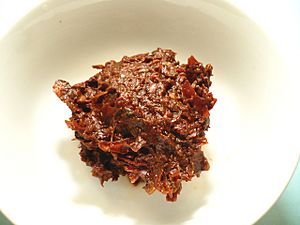Doubanjiang facts for kids
Quick facts for kids Doubanjiang |
|||||||||||||||
|---|---|---|---|---|---|---|---|---|---|---|---|---|---|---|---|

Spicy doubanjiang
|
|||||||||||||||
| Simplified Chinese | 豆瓣酱 | ||||||||||||||
| Traditional Chinese | 豆瓣醬 | ||||||||||||||
| Literal meaning | "bean segments sauce" | ||||||||||||||
|
|||||||||||||||
Doubanjiang (Chinese: 豆瓣醬), also known as broad bean chili sauce, is a popular and tasty Chinese bean paste. It's made from fermented broad beans, chili peppers, soybeans, salt, and flour.
This special sauce is very important in Sichuan cuisine, which is famous for its spicy and bold flavors. People even call doubanjiang "the soul of Sichuan cuisine"! Many well-known Sichuan dishes, like mapo tofu and Sichuan hotpot, use doubanjiang as a main ingredient.
While it's most famous in Sichuan, other parts of China have their own versions. In places like Guangdong and Taiwan, the spicy Sichuan doubanjiang is sometimes called la-doubanjiang, which means "spicy doubanjiang," to tell it apart from their milder local sauces.
Contents
Types of Doubanjiang
Pixian Doubanjiang
The most famous type of doubanjiang comes from Pixian (now called Pidu District) in Sichuan province. It's known as Pixian doubanjiang (Chinese: 郫县豆瓣酱). What makes it special is its very long fermentation time, often more than three years! This process happens under the sun. There's an old saying about how it's made: "flip it over during daytime, expose it at night, sunbathe it in sunny days, cover it when it rains."
The unique taste of Pixian doubanjiang comes from its home in Pixian. This area has lots of sunshine, humid air, and clean water. These conditions are perfect for the tiny living things (microbes) that help the sauce ferment. These special microbes create the deep and complex flavor of Pixian doubanjiang.
Pixian doubanjiang has a reddish-brown color and a rich, savory taste called umami. To use it, chefs usually fry it in oil first. This helps its color and amazing smell spread through the dish.
How Pixian Doubanjiang is Made
Pixian doubanjiang is a special product with a "geographical indication" (GI) label. This means it has to be made in a certain place using specific methods to ensure its quality.
Here are the main steps:
- Ingredients: It must use special "Erjingtiao" chili peppers from Pixian and nearby areas. The broad beans come from east Sichuan or Yunnan province. The water used is from underground in Pixian.
- Making the sauce:
* First, broad beans are soaked and their skins are removed. Then, a special starter culture (called Qu) is added, and the beans ferment for over six months. * Next, the Erjingtiao chili peppers are salted, crushed, and also fermented. * Finally, the fermented broad beans and chili peppers are mixed together in a specific amount. This mixture is then sun-dried for another three months to ferment even more. * After all these steps, the delicious Pixian doubanjiang is ready!
- Quality: Pixian doubanjiang is graded into three classes:
* Premium grade: This is the best! It's reddish-brown, shiny with oil, smells strongly of chili, and tastes very rich. The bean pieces are crispy and melt in your mouth, leaving a long-lasting flavor. * Grade I: This one is light red-brown, partly shiny, and has a good chili smell and savory taste. * Grade II: This grade is red or light red-brown, shiny but not coated in oil. The bean pieces might not be as fragrant, and the taste doesn't last as long.
Other Types of Doubanjiang
You can also find other kinds of doubanjiang. Some are made at home or in factories and don't ferment for as long as the Pixian version.
- Hongyou doubanjiang: This type (Chinese: 红油豆瓣) means "doubanjiang in red chili oil." It's not fermented and often has extra spices. The chili oil can be made from any type of chili.
- Binzhou watermelon doubanjiang: From Binzhou, Shandong, this doubanjiang (Chinese: 滨州西瓜豆瓣酱) is not spicy. It's made with soybeans, watermelon, flour, and salt. It's usually fermented without any added chemicals.
Outside of Sichuan, many doubanjiang sauces are not spicy. Sometimes, they are called "Toban djan." A well-known brand that sells Toban djan in Asian grocery stores is Lee Kum Kee.
Storing Doubanjiang
Doubanjiang is a fermented sauce, which means it contains tiny living things (microbes). To keep it fresh after you open it, it's best to store it in a sealed glass container in the refrigerator. If you leave it out at room temperature, these microbes can grow faster, and the sauce might spoil. Also, doubanjiang has fat in it, which can go bad if left out too long.
Dishes Made with Doubanjiang
Doubanjiang is a key ingredient in many delicious Chinese dishes, especially from Sichuan. Pixian doubanjiang is truly known as the "soul of Sichuan cuisine."
Some famous dishes that use doubanjiang include:
- Mapo tofu
- Twice-cooked pork
- Sichuan hot pot
- Yuxiang shredded pork
- Kung Pao chicken
- Stir-fried pork
- Shuizhu pork (also called water-boiled pork)
Sichuan restaurants are found all over the world. However, sometimes the taste of Sichuan dishes made outside of Sichuan province might not be exactly the same. This can happen if the special ingredients, like real Pixian doubanjiang or specific chili peppers, aren't used. Also, a chef's skill in cooking with these ingredients can make a big difference in the final taste.
See also
 In Spanish: Doubanjiang para niños
In Spanish: Doubanjiang para niños


